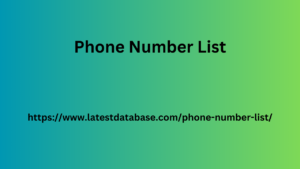reating accessible documents is essential to ensure that everyone, regardless of their abilities, can access and understand the information presented. This guide outlines some of the best practices to follow when creating accessible documents.
Understanding Accessibility
Accessibility in document creation refers to making content usable by people with disabilities. This includes individuals with visual impairments, hearing impairments, cognitive disabilities, and motor impairments. By following accessibility guidelines, you can ensure that your documents are inclusive and reach a wider audience.
Using Headings and Subheadings
- Purpose: Headings and subheadings provide structure and organization to your document, making it easier to navigate. They also aid in screen reader software, which can read the headings aloud to visually impaired users.
- Best Practices:
- Use heading levels (H1, H2, H3, etc.) in a Jamaica Phone Number logical hierarchy to indicate the importance of each section.
- Start with H1 for the main title and use lower levels for subsequent sections.
- Avoid using headings solely for styling purposes.
Proper Formatting and Styling
- Purpose: Consistent formatting and styling enhance readability and comprehension. It also helps screen reader software interpret the content accurately.
- Best Practices:
- Use plain text whenever possible and avoid excessive use of formatting elements like bold, italic, or underline.
- Use a clear and readable font with a sufficient size.
- Ensure adequate contrast between text and background colors.
- Use consistent spacing and line breaks.
Alternative Text for Images and Multimedia
- Purpose: Alternative text (alt text) provides a textual description of images, charts, and other multimedia elements. It is crucial for visually impaired users who cannot see the image.
- Best Practices:
- Provide concise and informative alt text for all images.
- Avoid using phrases like “image of” or “picture of” at the beginning of alt text.
- Use descriptive language that accurately conveys the content of the image.
- For decorative images that do not add meaningful content, use an empty alt text attribute or set it to “decorative.”
Table Accessibility
- Purpose: Tables are Email Laboratory used to present structured data in a clear and organized manner. However, they can be challenging for screen reader users to understand without proper accessibility considerations.
- Best Practices:
- Use table headers (TH) to define the content of each column and row.
- Use table summaries to provide a brief overview of the table’s purpose and content.
- Avoid using nested tables, as they can be difficult to interpret by assistive technologies.
Document Structure and Navigation
- Purpose: A well-structured document with clear navigation aids users in finding the information they need.
- Best Practices:
- Use a consistent and logical BW Lists structure throughout the document.
- Include a table of contents or headings list to help users navigate the document.
- Use bookmarks or hyperlinks to create internal links within the document.
Testing and Validation
- Purpose: Testing your document with assistive technologies is essential to identify and address any accessibility issues.
- Best Practices:
- Use screen reader software to test the document’s readability and navigation.
- Test the document with different assistive technologies to ensure compatibility.
- Validate the document using accessibility checking tools to identify potential errors.
Conclusion
By following these best practices, you can create accessible documents that are inclusive and usable by everyone. Remember to prioritize accessibility from the beginning of the document creation process to ensure a positive user experience.

